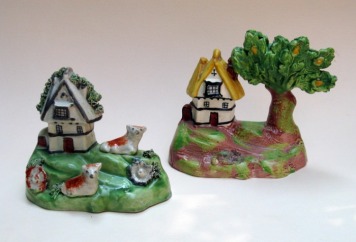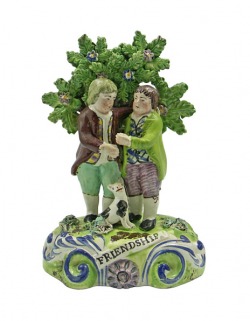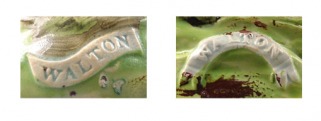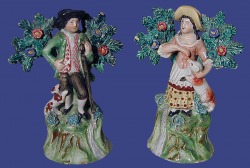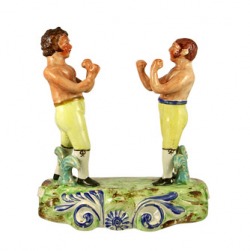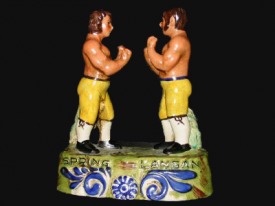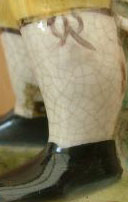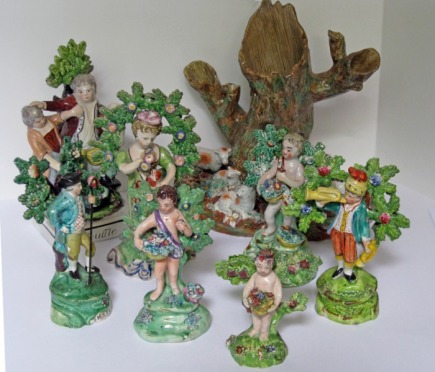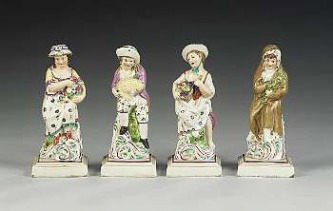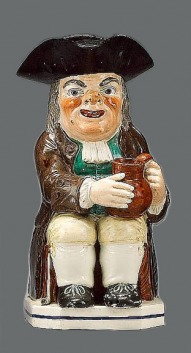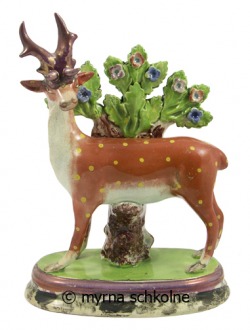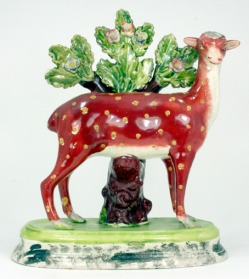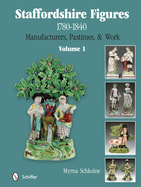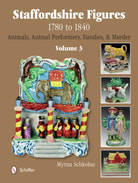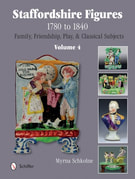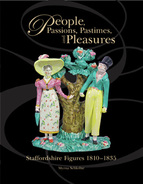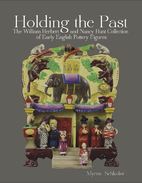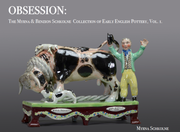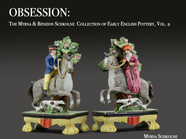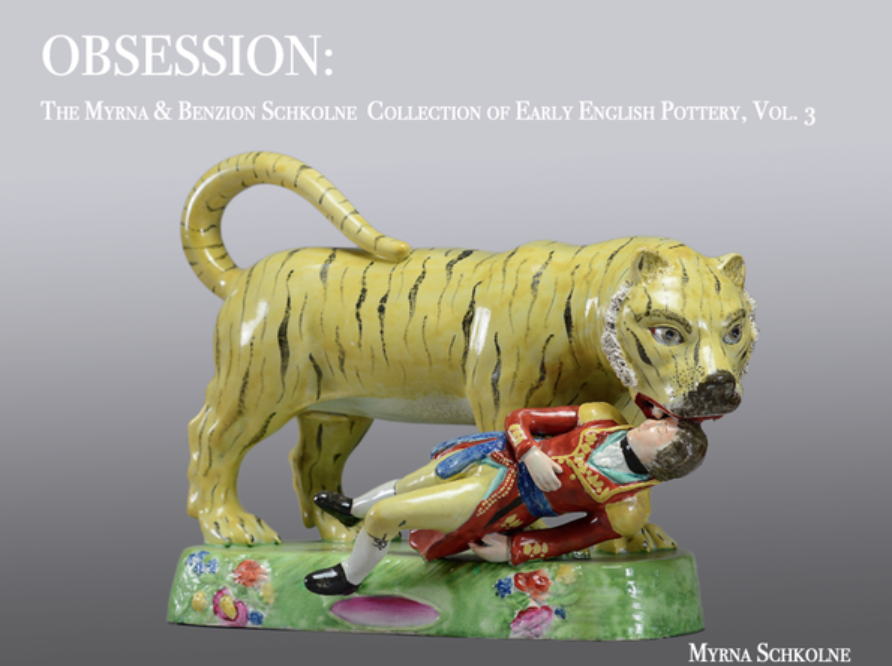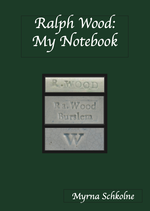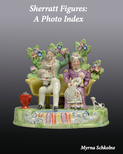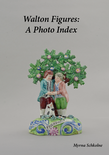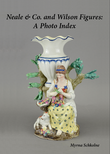In this crumbling real estate market, I have bought a house...but a Staffordshire one, of course. My collecting style has me constantly scrounging around for the unexpected, and persistence pays off. But to begin at the beginning: Right before my book was published, I was thrilled to find a little Staffordshire house with a bocage alongside it in the stock of John Howard. This was a Rare Thing. If you are thinking 'pastille burner, forget it! This little house was simply made to be pretty. At 4" high, it was just the sweetest toy. Totally flat back, and open beneath.
Such little houses are unusual things. So to my joy, last week, when I visited Elinor Penna, I found yet another earthenware vignette comprising the same little house. This time, it was accompanied by some friendly sheep and lovely large flowers. It came home with me, and you can see the two, side by side, below.
|
Figures like these are amongst the least costly to acquire. But owning them--and making 'connections' between the figures in my collection--adds immeasurably to my joy in collecting.
0 Comments
Have added a page titled "Beware" to this site. It illustrates figures frequently described as antique. Reproductions, fakes...am not sure what you call them in these circumstances, but they are not the Real Thing! What's odd about this description accompanying a Toby jug on a dealer's web site?
A very rare Ralph Wood enamel Bacchus and Pan toby jug. It has an unusual mask spout and a finely decorated handle, rich enamel colours which are highlighted with pink lustre. A red flag goes up right away. Ralph Wood III, the last of an illustrious potting line, died in 1801. Lustering was introduced commercially from 1805....at which time Ralph Wood was long gone. Of course, owning a Ralph Wood Toby jug is very nice--but then you need to be sure it was made by Ralph Wood. A tangential subject: I love the work of Kevin Low, who uses early Staffordshire figures as inspiration for his stunning, colorful art. The past peeps out from each of Kevin's modern, moving masterpieces. . One of my favorites is below. 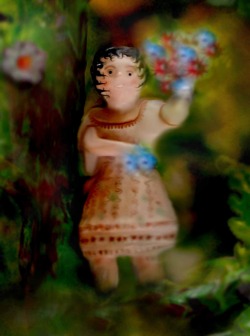 'The Showman's Daughter’ Image – 77.45cm x 65cm Giclée print Edition of 25 A picture is worth a thousand words, so Kevin's works tell you more than I could. But from his site:
Using primarily 19th century ceramics as his source material, he manipulates the work with vast changes in scale, flooding his work with colour. His characters are all in some way part of an epic, each one inexplicably connected with the other. Perhaps this is through marriage, love, or lust. The only clue we have is in their titles, faint hints at love, loss and lust. What results from this strange archaeology, is a queer resurrection: a celebration of a rich gaudy past that never existed. Intriguing? Check out http://www.kevinlow.co.uk ...and look at all the galleries! This pearlware figure, titled Friendship, bears the mark of John Walton. The vignette is thought to be after an engraving that accompanied The History of Sanford and Merton. This moralistic children's tale was popular in the early 1800s and it tells of the reconciliation between two quarreling boys. (To see the engraving alongside the figure, see Schkolne, Myrna: People, Passions, Pastimes, and Pleasures: Staffordshire Figures 1810-1835.) Marked Walton figures are usually well modeled, glazed,and enameled. Some of the Potteries' finest figures bear the Walton banner. However, there are even more figure groups seem so like Walton groups, yet the familiar Walton banner is nowhere to be found. Even if the modeling and enameling are evocative of Walton, there is no basis for attributing unmarked figures to Walton. His style was so generic that credit for similar figures may well go to one or other of the 100 odd figure potters who potted in the Potteries in the early 1800s. Fine Walton figures that have survived the centuries unscathed do exist. Some simply sing! I have recorded 99 marked Walton figure forms. An additional 11 figures were probably made to pair with examples on my list. On the whole, the figures reflect contemporary rather than classical themes, they have bocages, and they stand on green mound bases.The range of figures is extraordinary. A rare figure of Diana seems to be the earliest Walton figure, stylistically, that I have seen. She is atypical in that she is a heavy-hipped classical lady and stands sometimes on a rectangular base (brown, white with line, or vermicular--not green!). She never has a bocage and was probably made circa 1810. The only Walton figure that can be dated with some certainty is the stunning figure of the pugilists Spring and Langan. This rare figure (I can trace only 3 examples) was made in commemoration of the famous 1824 prize fights between Tom Spring and Jack Langan. It bears each pugilist's name on a scroll at each end and the Walton scroll on the back. For more photographs of this phenomenal figure, taken from various angles, see my book. Collector's Caution! The Walton mark alone is no indication of age, for marked Walton replicas were produced into the 20th century. Later TENDERNESS appears fairly frequently, as do little shepherd and shepherdesses. Watch for simple bocages, lettering usually without serifs, and different color palette and glazes as clues to their later origins. If in doubt, ask me before buying! But these copies are absolute gems compared to the even later "Staffordshire" objects of Asian origin that have popped up in the last twenty or so years. Walton's rare and appealing figure of Spring and Langan unfortunately falls into this category and there are crude reproductions on the market. I seem to have a part-time career fighting these fakes. Some sellers auction them honestly; most do not. To be fair, some sellers really think they have the genuine thing. I know this would be laughable were it not so sad. Even collectors with impaired vision should be able to recognize these as copies, albeit in a dense fog. Last year, I helped get an eBay sale undone when a collector parted with GBP 400 for one of these figures, advertised as The Real Thing. Recently, a deluded eBay seller would not part with his 'treasure' to a high bidder--it had not reached its even loftier reserve! Below is one of the nasty reproduction of Spring and Langan. Note the crazing added to the leg. Avoid a Walton reproduction by buying from a reputable dealer. You may pay a little more, but in the long run it will cost you less. If in doubt about buying a Walton figure, please ask me before you commit!
Not much green left in my wallet after my trip to NY for wedding-related shopping. Mother of the bride is, I am learning, an unbelievably costly role. The weather was yucky, the city was packed. I did not get to go to my favorite place in the city, the NY Public Library on 42nd and 5th. You could lock me in there. I love it so much. But every cloud has a silver lining, and the platinum lining was my visit to a very special person. A pilgrimage really, because I try to do this one at least once each year. Neale pearlware figures may be marked NEALE & Co., such as the four Neale figures of the Seasons above. These figures are distinctly modeled and decorated. Each figure stands on a rococo scrollwork mound, picked out in bright pink/puce and turquoise, which is in turn mounted on a square base. The enamels are sweet, like the figures themselves.Sometimes the figures are impressed beneath with the subject’s name. Most commonly, that name belongs to one of the Four Seasons, or it will be Apollo or Ceres. 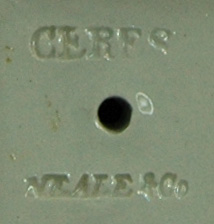 Base of a marked pearlware figure of Ceres. 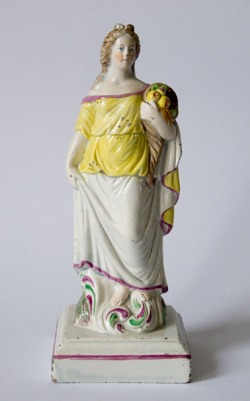 This pearlware figure of Ceres bears the Neale mark. 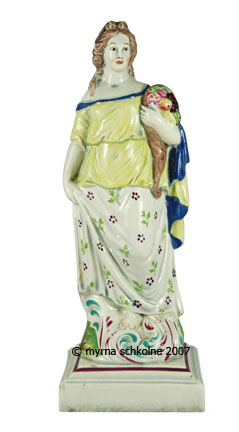 Unmarked pearlware figure of Ceres. James Neale was the proprietor of a potbank in Hanley from 1778. By 1783, Robert Wilson was his partner. By 1791, Neale had retired and the partnership dissolved in 1792. Thereafter, the potbank continued in the Wilson family until 1820. Figures impressed NEALE & CO. date from between about 1780 to 1791, this being the period of Neale's involvement in the trade. After Neale's retirement, the same figures continued in production, sometimes marked with an impressed crown above the letter G.The same figures can also be found with no maker's mark. Clearly we know NEALE & CO figures are 18th century, but other unmarked figures from identical molds may be 18th or 19th century.The 18th century enamel coloring was timeless and so well suited to the figures' delicate modeling that the Wilsons may have retained the pretty palette. The Wilsons probably realized the ideal match between the style and the decoration of these molds and did not tamper with the petite NEALE & CO figures. Marked Neale figures go beyond the small figures discussed above. Toby jugs decorated in enamel colors and marked NEALE & CO are usually on marbled bases, and Toby customarily has a particularly warty nose. The enamels are brighter than I would expect for the 1780-90 period, but they retain a delicate silkiness--and what do we really know anyway? Other Neale Staffordshire figures can be seen in the scant pages devoted to them in Diane Edwards's book "Neale Pottery and Porcelain." You will also find reference to other Neale and Wilson marks, none of which seems to have popped up on a pearlware figure--yet. Tell us about your Neale figures by commenting on this blog.
And follow MyrnaSchkolne onTwitter for site updates and other figure sightings! "Sherratt" figures are so delightfully quirky that the trade is quick to apply a "Sherratt" lable where possible...and it can help boost price. Problem is that most of the trade aren't sure what is "Sherratt." Remember to read the Hodkinsons' book if you want to know all the details. At the back of the book is a list of all known "Sherratt" figures. NOT on that list is a tithe pig group. And I can confirm that I have never seen a Sherratt tithe pig. So I was amused to read the following in the May Maine Antiques Digest, page 38C, from a report on the Chester County Antique Show: How do I know this figure is "Sherratt?" Well, the floral garlands applied to the base of this figure are almost "Sherratt" signatures. If you think you have a "Sherratt" figure but are unsure, send me a picture. myrna@schkolne.com
Please follow on Twitter (MyrnaSchkolne) to get updates to this website. Attributing figures to a source of common origin sounds so boring. Yet doing this adds a whole other dimension to collecting. Figures become pieces in a giant jig saw puzzle. Connecting the right pieces completes the puzzle. Who needs Sudoku? So how do we know that the figure below is "Sherratt?" Firstly, look at the base. Scroll down to the previous posting and look at the second lion pictured there. It stands on the same base, a base only found on figures with other "Sherratt" features. And what other "Sherratt" attributes does this deer have? Look at the bocage! You will recognize it as the same bocage we saw on the Doctor Syntax group in the posting below. My amazingly brilliant friends, Malcolm and Judith Hodkinson, have meticulously identified "Sherratt attributes and they dub this bocage form 'triple oak leaf'; they call the flowers 'mayflowers'. So based on the base and bocage, our deer is "Sherratt." And every deer needs a doe, so here she is: Recognize the base again? And how about the triple oak leaf bocage, with mayflowers? This figure too is definitely "Sherratt." Note that we have to be careful about attributing. One swallow does not make a summer. And one feature does not make for an attribution! We are only be sure that our deer are 'Sherratt' because we find the base and the bocage leaves and flowers repeatedly on other figures that share these and other "Sherratt" attributes. Please follow me on Twitter (MyrnaSchkolne) to get updates to this website. Paragraph.
|
Archives
September 2023
All material on this website is protected by copyright law. You may link to this site from your site, but please contact Myrna if you wish to reproduce any of this material elsewhere. |
